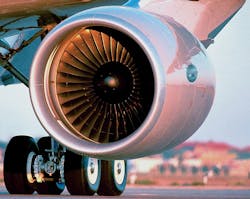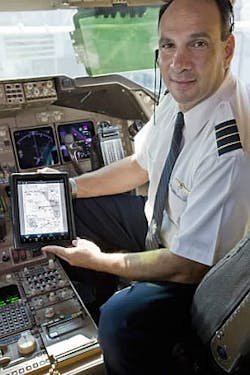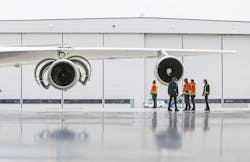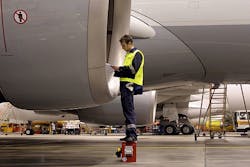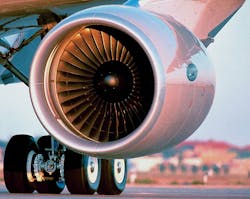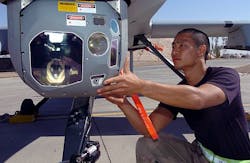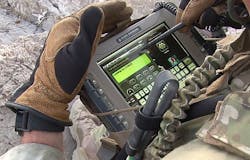Aerospace and defense organizations reap rewards from Internet of Things
Government agencies are partnering with commercial technology firms to leverage the Internet of Things, Big Data, and predictive analytics to achieve greater efficiency and productivity, new business, and modern, integrated workflows.
The proliferation of smart devices, electronic equipment connected to other devices and networks, is a game-changer. It is integral to the Big Data revolution and the Internet of Things (IoT), “the network of physical objects embedded with electronics, software, sensors, and network connectivity that enables these objects to collect and exchange data,” as defined by Wikipedia.The IoT, including IoT products and services, continues to transform the way individuals and organizations do business. It is a natural fit for the aerospace and defense community – replete with sensors, handheld devices, and myriad advanced, connected electronics systems focused on network-centric data capture, communication, exploitation, and storage. A variety of aerospace organizations, early IoT adopters, are already reaping the benefits and developing new business models and revenue streams, modernizing manufacturing, integrating global engineering workflows, and increasing efficiencies across their own business and that of their customers.
The Internet of Things is a powerful force within the aerospace and defense industry today, SAP officials in Walldorf, Germany, reveal. “Unlike some industry sectors that are early in the IoT maturity spectrum, [aerospace and defense] companies have been successfully implementing sensors and computerized automation for decades in their manufacturing operations and products.
“Leading aerospace and defense companies that invested early in IoT technologies are now realizing returns that range from overall product cost reduction due to manufacturing automation to delivering a better customer experience with preventive maintenance (resulting in higher product reliability and higher customer satisfaction),” SAP officials affirm. Successful aerospace and defense companies of the future are creating new products and services, transforming their businesses with new processes that fulfill the IoT approach, and upgrading their technology infrastructure with Big Data, mobile, cloud, analytics, and other applications, they add.
IoT standards
“Ultimately, with OCF specifications, protocols, and open source projects, a wide-range of consumer, enterprise, and embedded devices and sensors from a variety of manufacturers, can securely and seamlessly interact with one another,” officials say. “The OCF unifies leading companies at all levels – silicon, software, platform, and finished-goods – dedicated to providing this key interoperability element of an IoT solution.”
The OCF’s vision for IoT is that billions of connected devices (appliances, phones, computers, industrial equipment) will communicate with one another regardless of manufacturer, operating system, chipset, or transport. With the OCF fulfilling this promise, anyone – from a large technology company to a maker in their garage – can adopt the open standards of OCF to innovate and compete, helping ensure secure interoperability for consumers, business, and industry, officials say.
“We believe in a future where all of the devices in our lives are connected to enable ways of living and working that we can’t even imagine today. The only way to unlock the unlimited possibilities for innovation in the Internet of Things is to unify our work with industry peers. This collaboration is an exciting step in that direction,” says Doug Fisher, senior vice president and general manager, Software and Services Group, Intel in Portland, Oregon.
In 2016, 5.5 million new things will get connected every day, predict analysts at research company Gartner in Stamford, Connecticut. The number of connected devices in use worldwide will exceed six billion this year -- a 30 percent increase over 2015 – and reach 20.8 billion by 2020, Gartner analysts forecast.
“IoT services are the real driver of value in IoT, and increasing attention is being focused on new services by end-user organizations and vendors," explains Jim Tully, vice president and analyst at Gartner. Indeed, the IoT will support total services spending of $235 billion in 2016 – up 22 percent from 2015, he says. IoT services are dominated by the professional category, whereby businesses contract with external providers to design, install, and operate IoT systems; yet, connectivity services provided by communications service providers and consumer services are expected to grow at a faster pace, according to Gartner data.
FAA data migration and modernization
The Federal Aviation Administration (FAA) in Washington is moving away from FAA-owned physical data centers, partnering with commercial industry to harness the Cloud to increase efficiencies, reduce operating costs, and improve information sharing.
FAA officials have contracted CSC Government Solutions in Falls Church, Virginia, to lead an overall integration effort that include Amazon Web Services, Microsoft Azure, and other providers of Cloud products and services. The $108 million, 10-year contract has the potential to reach $1 billion over the length of agreement), and will enable the FAA to take advantage of Cloud technologies, such as Software-as-a-Service, Platform-as-a-Service (also called System-as-a-service), Infrastructure-as-a-Service, and colocation. It will provide the FAA with on-demand, pay-per-use computing and data storage over a secure FAA Telecommunications Infrastructure (FTI), which supports the agency’s telecommunications services and National Airspace System (NAS) operations, including the Next Generation Air Transportation System (NextGen).
“The move away from FAA-owned data centers to outsourced locations will increase efficiencies and flexibility while saving time and money – all while making information-sharing much easier,” CSC officials say. “The FAA can now purchase information technology (IT) as-a-service rather than buying expensive facilities and hardware that quickly becomes outdated. The agency will be able to keep up with industry standards and innovate on a much larger scale.”
The contract calls on CSC, Amazon Web Services (AWS), Microsoft Azure, and other strategic business partners to deliver cost-effective cloud services, data center consolidation, and cloud migration capabilities in a program to be rolled out in phases. The FAA and its partners are currently working to assess all existing applications and determine those suitable for the Cloud. The project team will then start to consolidate FAA data centers, establish the hardware and software infrastructure, and migrate FAA data and systems to a hybrid cloud environment. Upon completion, users will be able to store and access information from any location at any time on approved devices with an Internet connection, officials describe.
The team will use the CSC Agility Platform cloud management tool to orchestrate efficient cloud deployment while leveraging alliance partners for data and cloud services, officials say. “CSC and our alliance partners are demonstrating the unique value that we as a team can bring to deliver an innovative, next-gen IT cloud solution that drives the FAA’s mission forward,” says Mike Lawrie, CSC’s president and chief executive officer. “By coming together as we have, we are in a unique position to help meet the agency’s operational and budgetary challenges over the life of the program.”
The team’s solution combines CSC’s on-premises services with cloud services from AWS and Microsoft Azure certified by the Federal Risk and Authorization Management Program (FedRAMP) – a government-wide program that provides a standardized approach to security assessment, authorization, and continuous monitoring for cloud products and services.
“As the agency now moves to a hybrid cloud environment and consolidates its data centers, Microsoft’s Azure will work across applications, software, operating systems, and data to ensure success in support of the FAA’s mission of providing the safest, most efficient aerospace system in the world,” says Greg Myers, vice president of Microsoft Federal.
“Government adoption of cloud computing for mission applications is accelerating rapidly,” affirms Teresa Carlson, vice president of worldwide public sector, Amazon Web Services (AWS). “With AWS’s security and compliance standards – like FedRAMP, ITAR, and SRG – CSC will be able to rapidly enable FAA to realize the benefits of agility, cost savings, and flexibility.”
Demand for cloud-computing services is growing rapidly in the private sector and among government agencies seeking to cut costs, consolidate data, improve data security, and improve information sharing. In fact, Cloud-computing revenue at both Amazon Web Services and Microsoft grew by more than 80 percent year over year in 2015 and now exceeds $6 billion annually.
Predictive analytics
Aerospace organizations are harnessing the power of the IoT and Big Data for predictive analytics, defined as the use of data, software algorithms, and electronics hardware to predict the likelihood of future outcomes based on historical data. Companies are exploiting patterns in data to identify risks and opportunities, speed and enhance decision making, increase efficiency, and save time, money, and other resources. Myriad aerospace engineers and executives see great promise in predictive analytics to transform operations and business models.
Experts at Pratt & Whitney, a unit of United Technologies Corp. with headquarters in East Hartford, Connecticut, predict that Big Data and IoT will connect airlines with original equipment manufacturers (OEMs) and maintenance, repair, and overhaul (MRO) facilities to anticipate repairs before a plane lands at an airport. Proactive maintenance practices can enable more efficient operations, increased productivity, enhanced customer experiences, cost savings, and business expansion, among other benefits.
Pratt & Whitney Vice President and Chief Information Officer Larry Volz considers the move toward predictive analytics as “a paradigm shift in the way the business has to operate.”
“Today's aircraft and engines are generating more real-time data than ever before,” affirms Pratt & Whitney Aftermarket President Matthew Bromberg. “Big Data enables us to capture and share this data in a fashion never before thought possible.” Pratt & Whitney engineers are currently using Big Data technologies to predict engine inflight shutdowns and improve technical support. “Looking forward, Big Data will connect the entire MRO network. It will align airlines, MROs, and OEMs. Together we will anticipate repairs before the aircraft lands.”
Engine performance data analytics
One such project underway at Pratt & Whitney is focusing on solving the challenge of unscheduled engine maintenance events. The Big Data project, which targets PW4000 engines in service on wide-body aircraft, is the first step toward developing a predictive model for anticipating and preventing inflight shutdowns and engine-related delays and cancellations, describes Lynn Fraga, an analytics manager in engine services at Pratt & Whitney.
Pratt & Whitney currently captures roughly 100 parameters at multiple snapshots through a given flight, and that number will grow when the next generation of commercial engines enters service. The Geared Turbofan engine will collect 5,000 parameters continuously throughout a flight, generating massive amounts of data; at maturity, the Pratt & Whitney Geared Turbofan engine fleet will be generating more than two petabytes of data annually – the equivalent of a new American Library of Congress every year, officials say.
Pratt & Whitney engineers are working with IBM on better visualization of the data streams generated by the company’s commercial engines, and to help Pratt & Whitney broaden its current performance monitoring capabilities.
“Data only becomes useful when we're able to translate that to a value proposition,” Fraga says. “What we're trying to do is expand our forward-looking horizon to make those types of engine maintenance events highly predictive and to start to move our discussion from a reactive to a proactive maintenance discussion. We've developed a tool that proactively looks at these types of events and gives us an early warning and early detection on any potential fleet trends."
Defense deployment
Predictive analytics holds great promise outside of commercial aviation, and is being adopted by defense organizations. “It is definitely a move in government to take advantage of the reduced costs, integration, technology refresh – all the advantages the Internet of Things and Systems-as-a-Service can provide,” describes Brad Curran, aerospace & defense industry principal at Frost & Sullivan. “It’s a big trend -- not just for enterprise networks in Washington and on military bases, but also for tactical computing and tactical wireless networks. It’s all being worked on right now.
“The U.S. Department of Defense (DOD) has a goal of utilizing successful civilian-based cloud computing and Big Data analysis, including wireless mobile networks and applications,” Curran continues. Challenges exist, however, and include: integrating with older, legacy systems; staying secure from hackers and jammers; reliability; and things like that, that military networks have to have more than a civilian network.
To overcome challenges and exploit the advantages of the IoT, the Cloud, Big Data, and predictive analytics, government agencies – including the DOD, FAA, and NASA – are partnering with commercial technology providers. “Amazon is a prime example of a commercial company that provides cloud services to government agencies. HP is another one,” Curran says.
HP won a large contract with the U.S. Defense Information Systems Agency (DISA), part of the DOD which “provides, operates, and assures command and control, information sharing capabilities, and a globally accessible enterprise information infrastructure in direct support to joint warfighters, National level leaders, and other mission and coalition partners across the full spectrum of operations.” DISA’s goal, in fact, is “Information superiority in defense of our Nation.”
DOD officials dedicate some networks to a designated cloud, to ensure critical and classified data is not mixed in with everyone else’s information; in some cases, they use commercial companies’ services, Curran explains. They store highly classified information on milCloud, a cloud-services product portfolio managed by DISA that is still in its early stages. DOD and DISA engineers are trying to implement commercial technology but still keep milCloud secure, he describes. milCloud features an integrated suite of capabilities designed to drive agility into the development, deployment, and maintenance of secure DOD applications, and leverages a combination of mature commercial off the shelf (COTS) and government-developed technology to deliver cloud services tailored to needs of the DOD, according to DISA officials.
Officials in the FedRAMP program and U.S. Air Force are working on a tactical cloud in support of aircraft and airborne intelligence, surveillance, and reconnaissance (ISR) platforms, Curran says. At the same time, U.S. Navy officials are working with commercial partners to develop the Navy Tactical Cloud Reference Implementation (TCRI). It is intended to provide on-demand access to shared sensors and computing resources, as well as to perform advanced analytics and reasoning on the extensive amount of data being captured.
Charles River Analytics Inc. in Cambridge, Massachusetts, won a Navy Tactical Cloud contract – valued over $400,000, with options for an additional $1 million over two years – from the Office of Naval Research (ONR) to bring Big Data capabilities to the warfighting environment. Charles River engineers will develop Navalytics, a framework for probabilistic, multi-source naval analytics and analytic services, to provide a way to rapidly develop and deploy mission-critical analytics.
Air Force in Cyberspace
“Each Airman needs access to accurate, timely, and usable information, regardless of location; Airmen need this information to make quick, smart decisions – whether on base or at the tip of the spear,” Air Force officials describe. “Exploiting cyberspace allows us to do these things, and thwart our adversaries from doing the same.”
To that end, Air Force officials and engineers are dedicated to the following elements:
Joint Information Environment (JIE)
The JIE is a set of common standards agreed to by the Services that will enable independent Service networks to participate in a shared infrastructure that is defensible, redundant, and resilient...to deliver access at the point of need.
Data Center Consolidation (DCC)
The Air Force is implementing the OMB-directed Federal Data Center Consolidation Initiative to aggressively reduce over 500 identified data centers in the Air Force and create a more efficient data hosting environment.
DoD Enterprise Email (DEE)
The Air Force supports the JIE initiative and will implement DEE as the first on-ramp application as soon as practical.
Cloud Computing
In partnership with DISA, the DoD Cloud Broker, the Air Force is exploring the use of Cloud Computing to deliver ubiquitous access to relevant data at the point of need.
Mobility
The Air Force has begun testing a limited operational capability, using commercial mobile devices, with senior leaders and functional communities.
Unified Capabilities
The Air Force is migrating to IP services (voice, video, data, and related collaboration services) to deliver an integrated capability.
Data deluge
Government agencies, including the DOD and National Geospatial-intelligence Agency (NGA), are burdened with enormous amounts of data to be analyzed and manipulated. Given the amount of data being captured, they can’t send huge amounts of data; they need to process the data to be efficient and not to clog bandwidth, Curran says. As a result, anomaly change detection, visual enhancement, and similar tools developed in civilian world being applied by government agencies, he adds.
NGA officials partnered with software and hardware technology providers on an online portal for sharing geospatial data, including high-resolution imagery and full-motion video. Lockheed Martin and Esri engineers teamed up and used Esri's ArcGIS geographic information system to migrate NGA data to the portal, hosted by Amazon Web Services Commercial Cloud Services (C2S).
Lots of examples like that – government partnering with commercial businesses – exist today, Curran affirms. Defense Logistics Agency officials are working with companies like Boeing, Dell, and Microsoft to help handle the huge amounts of data they have to manipulate and update. After all, he says, nobody does logistics, inventory control, and supply chain management better.
U.S. Secretary of Defense Ashton “Ash” Carter is actively talking to Microsoft, Amazon, and other technology firms to utilize industry best practices, uncover joint research and development opportunities, increase the DOD’s efficiency in handling sensor data, and maximizing cybersecurity to ensure networks are protected, Curran describes.
“Years ago, DARPA invented the Internet – and industry took it and ran with it; now the DOD is going back to industry, trying to emulate commercial best practices and technology tools,” Curran says. Government agencies are taking “baby steps now” harnessing the IoT, he says, but it is going to be pervasive.
“It parallels what is going on in civilian life,” Curran explains. “We all have smartphones that we can do virtually anything with, and we’re just starting with the younger generation leading it and starting to take advantage of technology; it’s the same with military and other government agencies, which are just starting to leverage the benefits of IoT and all the latest miniaturization technologies. The only things limiting it are SWaP (size, weight, and power) and imagination; it’s just getting started and has a long way to go.”
Unlocking the potential of IoT
“Of all the current technology trends, the Internet of Things is perhaps the biggest one; it’s the one that’s going to give us the most disruption, as well as the most opportunity throughout the next five years,” says Bobby Koritala, chief product officer at Infogix, provider of data integrity and advanced analytics solutions in Naperville, Illinois. Koritala discusses how to capitalize on IoT in 2016, noting that several things need to be in place to unlock the potential of IoT.
You might also like:
Subscribe today to receive all the latest aerospace technology and engineering news, delivered directly to your e-mail inbox twice a week (Tuesdays and Thursdays). Sign upfor your free subscription to the Intelligent Inbox e-newsletter at http://www.intelligent-aerospace.com/subscribe.html.
Connect with Intelligent Aerospace on social media: Twitter (@IntelligentAero), LinkedIn,Google+, and Instagram.
Intelligent Aerospace
Global Aerospace Technology NetworkIntelligent Aerospace, the global aerospace technology network, reports on the latest tools, technologies, and trends of vital importance to aerospace professionals involved in air traffic control, airport operations, satellites and space, and commercial and military avionics on fixed-wing, rotor-wing, and unmanned aircraft throughout the world.
